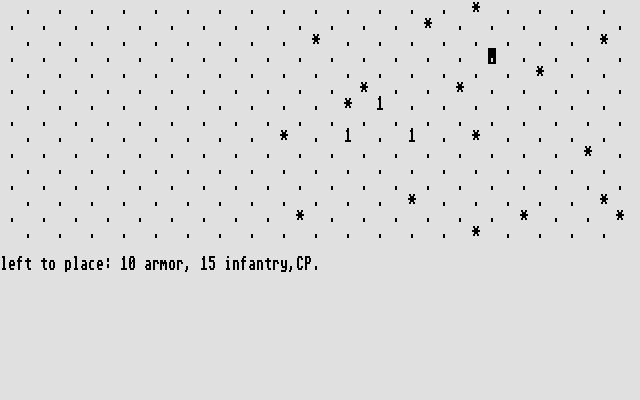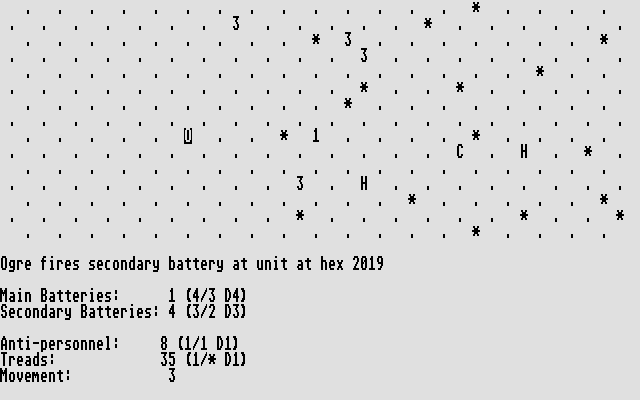Retro Replay Review
Gameplay
Ogre’s gameplay delivers a tense, turn-based experience that stays true to its 1977 MicroGame roots while adapting smoothly to a computerized format. You begin by placing your infantry squads, heavy tanks, missile tanks, howitzers, GEVs, and command post on a sparse battlefield grid marked by dots and occasional star craters. This initial deployment phase is deceptively simple, yet it sets the stage for the strategic dance that follows once the towering cybernetic tank crashes onto the scene.
(HEY YOU!! We hope you enjoy! We try not to run ads. So basically, this is a very expensive hobby running this site. Please consider joining us for updates, forums, and more. Network w/ us to make some cash or friends while retro gaming, and you can win some free retro games for posting. Okay, carry on 👍)
Once the Ogre arrives on the left side of the map, the game shifts into a five-phase loop: move your units, fire on the Ogre if in range, reposition your GEVs, watch the Ogre advance, and finally weather its devastating return fire. Each phase demands careful calculation—overextend your infantry and you risk them being wiped out in the Ogre’s final salvo, but hiding too cautiously may allow the Ogre to inch ever closer to your command post.
The balance between offense and defense is razor-thin. Howitzers pack a punch at long range but are vulnerable up close, while GEVs provide exceptional speed but fragile armor. Infantry units can chip away at the Ogre’s multiple layers of armor if properly supported, creating satisfying “softening up” maneuvers. The thrill of landing a decisive shot that disables one of the Ogre’s turrets or tracks is a highlight each time, reinforcing the high-stakes tug-of-war that defines the gameplay loop.
Graphics
Graphically, Ogre opts for a minimalist char-set presentation that faithfully mirrors the board game’s dot-and-star terrain. On both medium and high resolutions, the battlefield is rendered with crisp characters: “.” for open ground, “*” for craters, and unit symbols like “T” for heavy tanks or “O” for the Ogre. This retro aesthetic feels nostalgic and functional, allowing players to focus on tactics rather than flashy visuals.
While modern gamers may find the graphics humble by today’s standards, the clear iconography and high-contrast color schemes ensure readability even in the most chaotic moments. Animations are sparse but deliberate: unit movements update instantly on the grid, and firing sequences highlight target squares with brief flashes before applying damage. It’s all about clarity and speed, keeping the pace brisk without unnecessary embellishments.
Customization options for color palettes and grid sizes add a layer of accessibility, letting you tailor the view to your monitor’s resolution or your personal preference. For purists, the default palette evokes classic terminal interfaces, while those seeking a bit more visual flair can choose brighter hues and larger character sets. In either case, Ogre’s presentation remains true to its strategic core.
Story
Ogre’s narrative is refreshingly minimalistic, focusing squarely on the central conflict: a lone cybernetic tank’s march across the battlefield against your heterogeneous force. There’s no sprawling backstory or deep character arcs—just the raw, primal thrill of survival against an overwhelmingly powerful adversary. This simplicity keeps the tension razor-sharp, as your every move determines whether the Ogre is halted or your command post is crushed.
Despite the lack of a traditional campaign structure, each scenario feels like a microcosm of David versus Goliath. The lore of the Ogre itself, as a near-indestructible war machine, seeps through each turn as you witness its relentless advance and devastating firepower. Occasional text prompts describe the Ogre’s systems failing or tracks snapping, giving just enough narrative color to heighten the stakes without bogging down the flow.
The game’s homage to Steve Jackson’s original 1977 design lends a nostalgic charm, tapping into decades of tabletop wargaming heritage. Fans of the source material will appreciate the faithful adaptation, while newcomers can enjoy a distilled strategic challenge unburdened by extraneous plot threads. In Ogre, every skirmish is its own story, and the outcome of each can feel profoundly significant.
Overall Experience
Ogre offers a compelling blend of old-school design and modern convenience, making it an excellent choice for strategy enthusiasts seeking a deep yet approachable challenge. The turn-based mechanics are easy to learn but hard to master, ensuring that both newcomers and veteran tacticians find enduring replay value. Quick deployment and brisk phase transitions keep matches tight, with typical games lasting just long enough to feel intense without overstaying their welcome.
The game’s learning curve is gentle, thanks to clear on-screen instructions and a well-structured tutorial that walks you through each phase of play. Once you’ve grasped the basics, you’ll find yourself experimenting with bold flanking maneuvers, sacrificial infantry feints, and massed artillery barrages—all in an effort to stall or disable the Ogre before it overwhelms your command post.
Ultimately, Ogre’s beauty lies in its elegant simplicity and the high-pressure drama packed into each scenario. It may lack the graphical polish and narrative depth of contemporary AAA titles, but its strategic depth and frantic tension more than compensate. For players who relish a tough puzzle and appreciate retro-themed presentation, Ogre stands as a timeless wargame experience well worth adding to the digital tabletop.
 Retro Replay Retro Replay gaming reviews, news, emulation, geek stuff and more!
Retro Replay Retro Replay gaming reviews, news, emulation, geek stuff and more!







Reviews
There are no reviews yet.